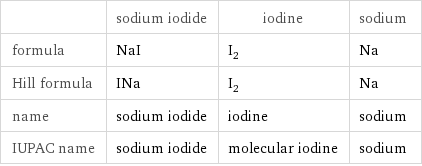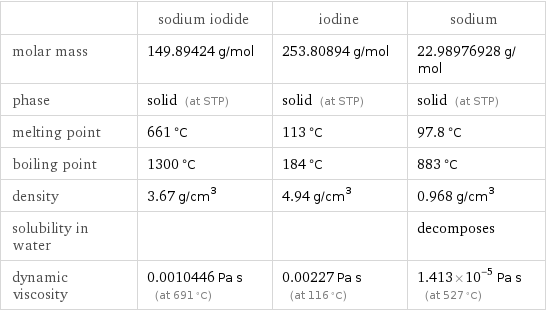Input interpretation

NaI sodium iodide ⟶ I_2 iodine + Na sodium
Balanced equation

Balance the chemical equation algebraically: NaI ⟶ I_2 + Na Add stoichiometric coefficients, c_i, to the reactants and products: c_1 NaI ⟶ c_2 I_2 + c_3 Na Set the number of atoms in the reactants equal to the number of atoms in the products for I and Na: I: | c_1 = 2 c_2 Na: | c_1 = c_3 Since the coefficients are relative quantities and underdetermined, choose a coefficient to set arbitrarily. To keep the coefficients small, the arbitrary value is ordinarily one. For instance, set c_2 = 1 and solve the system of equations for the remaining coefficients: c_1 = 2 c_2 = 1 c_3 = 2 Substitute the coefficients into the chemical reaction to obtain the balanced equation: Answer: | | 2 NaI ⟶ I_2 + 2 Na
Structures

⟶ +
Names

sodium iodide ⟶ iodine + sodium
Reaction thermodynamics
Enthalpy

| sodium iodide | iodine | sodium molecular enthalpy | -287.8 kJ/mol | 0 kJ/mol | 0 kJ/mol total enthalpy | -575.6 kJ/mol | 0 kJ/mol | 0 kJ/mol | H_initial = -575.6 kJ/mol | H_final = 0 kJ/mol | ΔH_rxn^0 | 0 kJ/mol - -575.6 kJ/mol = 575.6 kJ/mol (endothermic) | |
Entropy

| sodium iodide | iodine | sodium molecular entropy | 91 J/(mol K) | 116.1 J/(mol K) | 51 J/(mol K) total entropy | 182 J/(mol K) | 116.1 J/(mol K) | 102 J/(mol K) | S_initial = 182 J/(mol K) | S_final = 218.1 J/(mol K) | ΔS_rxn^0 | 218.1 J/(mol K) - 182 J/(mol K) = 36.13 J/(mol K) (endoentropic) | |
Equilibrium constant
![Construct the equilibrium constant, K, expression for: NaI ⟶ I_2 + Na Plan: • Balance the chemical equation. • Determine the stoichiometric numbers. • Assemble the activity expression for each chemical species. • Use the activity expressions to build the equilibrium constant expression. Write the balanced chemical equation: 2 NaI ⟶ I_2 + 2 Na Assign stoichiometric numbers, ν_i, using the stoichiometric coefficients, c_i, from the balanced chemical equation in the following manner: ν_i = -c_i for reactants and ν_i = c_i for products: chemical species | c_i | ν_i NaI | 2 | -2 I_2 | 1 | 1 Na | 2 | 2 Assemble the activity expressions accounting for the state of matter and ν_i: chemical species | c_i | ν_i | activity expression NaI | 2 | -2 | ([NaI])^(-2) I_2 | 1 | 1 | [I2] Na | 2 | 2 | ([Na])^2 The equilibrium constant symbol in the concentration basis is: K_c Mulitply the activity expressions to arrive at the K_c expression: Answer: | | K_c = ([NaI])^(-2) [I2] ([Na])^2 = ([I2] ([Na])^2)/([NaI])^2](../image_source/7c6fd90d3b2c8e4f320a83db06a07549.png)
Construct the equilibrium constant, K, expression for: NaI ⟶ I_2 + Na Plan: • Balance the chemical equation. • Determine the stoichiometric numbers. • Assemble the activity expression for each chemical species. • Use the activity expressions to build the equilibrium constant expression. Write the balanced chemical equation: 2 NaI ⟶ I_2 + 2 Na Assign stoichiometric numbers, ν_i, using the stoichiometric coefficients, c_i, from the balanced chemical equation in the following manner: ν_i = -c_i for reactants and ν_i = c_i for products: chemical species | c_i | ν_i NaI | 2 | -2 I_2 | 1 | 1 Na | 2 | 2 Assemble the activity expressions accounting for the state of matter and ν_i: chemical species | c_i | ν_i | activity expression NaI | 2 | -2 | ([NaI])^(-2) I_2 | 1 | 1 | [I2] Na | 2 | 2 | ([Na])^2 The equilibrium constant symbol in the concentration basis is: K_c Mulitply the activity expressions to arrive at the K_c expression: Answer: | | K_c = ([NaI])^(-2) [I2] ([Na])^2 = ([I2] ([Na])^2)/([NaI])^2
Rate of reaction
![Construct the rate of reaction expression for: NaI ⟶ I_2 + Na Plan: • Balance the chemical equation. • Determine the stoichiometric numbers. • Assemble the rate term for each chemical species. • Write the rate of reaction expression. Write the balanced chemical equation: 2 NaI ⟶ I_2 + 2 Na Assign stoichiometric numbers, ν_i, using the stoichiometric coefficients, c_i, from the balanced chemical equation in the following manner: ν_i = -c_i for reactants and ν_i = c_i for products: chemical species | c_i | ν_i NaI | 2 | -2 I_2 | 1 | 1 Na | 2 | 2 The rate term for each chemical species, B_i, is 1/ν_i(Δ[B_i])/(Δt) where [B_i] is the amount concentration and t is time: chemical species | c_i | ν_i | rate term NaI | 2 | -2 | -1/2 (Δ[NaI])/(Δt) I_2 | 1 | 1 | (Δ[I2])/(Δt) Na | 2 | 2 | 1/2 (Δ[Na])/(Δt) (for infinitesimal rate of change, replace Δ with d) Set the rate terms equal to each other to arrive at the rate expression: Answer: | | rate = -1/2 (Δ[NaI])/(Δt) = (Δ[I2])/(Δt) = 1/2 (Δ[Na])/(Δt) (assuming constant volume and no accumulation of intermediates or side products)](../image_source/916bffbf4a61c292697e069f19538833.png)
Construct the rate of reaction expression for: NaI ⟶ I_2 + Na Plan: • Balance the chemical equation. • Determine the stoichiometric numbers. • Assemble the rate term for each chemical species. • Write the rate of reaction expression. Write the balanced chemical equation: 2 NaI ⟶ I_2 + 2 Na Assign stoichiometric numbers, ν_i, using the stoichiometric coefficients, c_i, from the balanced chemical equation in the following manner: ν_i = -c_i for reactants and ν_i = c_i for products: chemical species | c_i | ν_i NaI | 2 | -2 I_2 | 1 | 1 Na | 2 | 2 The rate term for each chemical species, B_i, is 1/ν_i(Δ[B_i])/(Δt) where [B_i] is the amount concentration and t is time: chemical species | c_i | ν_i | rate term NaI | 2 | -2 | -1/2 (Δ[NaI])/(Δt) I_2 | 1 | 1 | (Δ[I2])/(Δt) Na | 2 | 2 | 1/2 (Δ[Na])/(Δt) (for infinitesimal rate of change, replace Δ with d) Set the rate terms equal to each other to arrive at the rate expression: Answer: | | rate = -1/2 (Δ[NaI])/(Δt) = (Δ[I2])/(Δt) = 1/2 (Δ[Na])/(Δt) (assuming constant volume and no accumulation of intermediates or side products)
Chemical names and formulas

| sodium iodide | iodine | sodium formula | NaI | I_2 | Na Hill formula | INa | I_2 | Na name | sodium iodide | iodine | sodium IUPAC name | sodium iodide | molecular iodine | sodium
Substance properties

| sodium iodide | iodine | sodium molar mass | 149.89424 g/mol | 253.80894 g/mol | 22.98976928 g/mol phase | solid (at STP) | solid (at STP) | solid (at STP) melting point | 661 °C | 113 °C | 97.8 °C boiling point | 1300 °C | 184 °C | 883 °C density | 3.67 g/cm^3 | 4.94 g/cm^3 | 0.968 g/cm^3 solubility in water | | | decomposes dynamic viscosity | 0.0010446 Pa s (at 691 °C) | 0.00227 Pa s (at 116 °C) | 1.413×10^-5 Pa s (at 527 °C)
Units
